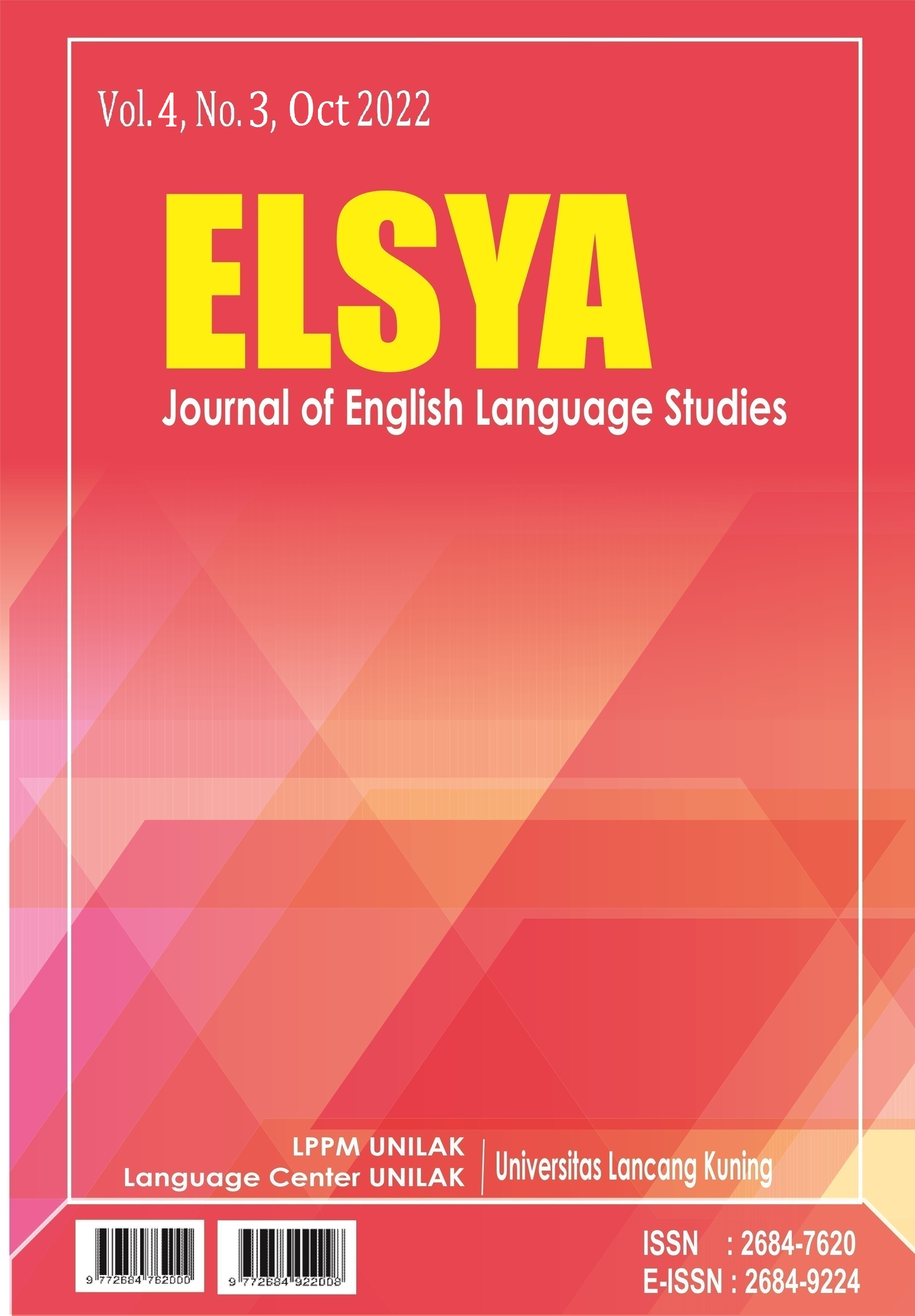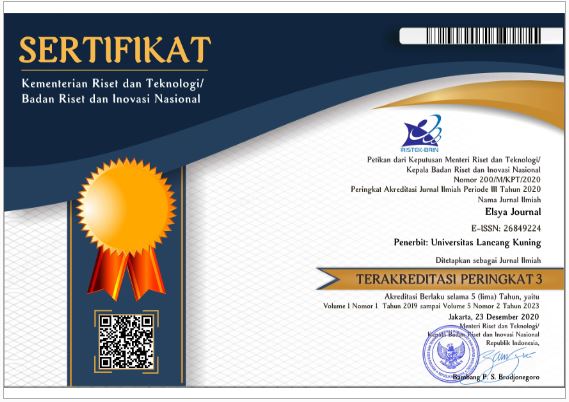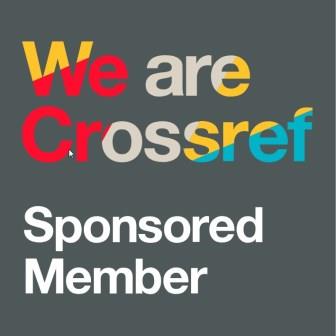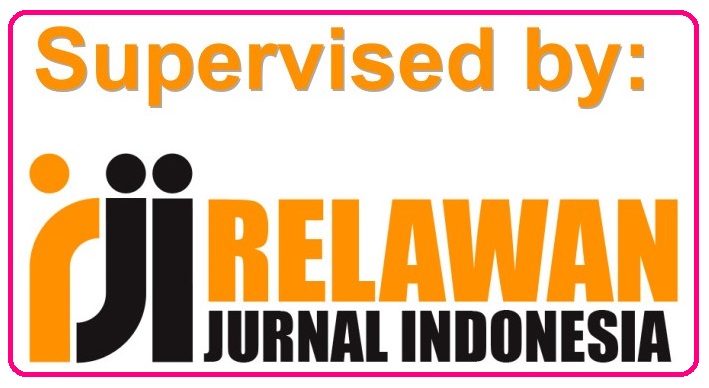Incorporating English Skills in Blended Learning During the COVID-19 Pandemic: A Narrative Inquiry
Abstract
The present study mainly attempts to explore the experiences of the two English language lecturers in incorporating English skills in blended learning during the COVID-19 pandemic and its effects on teaching professionalism considering that few studies discuss the ways of incorporating English skills in blended learning in more detail. To investigate the lecturers’ experiences, a narrative inquiry was employed in this study. Data were collected through narrative interviews with two English language lecturers at one of the Indonesian higher educations. The findings reveal that blended learning can be a better solution for learning activities amidst the COVID-19 pandemic. Regarding English skills incorporation in blended learning, it was found that the English lecturers used a number of ways of teaching English. First, creating a fun class in blended learning by using some applications like YouTube, video, Instagram, Facebook, and others in incorporating English skills. Second, asking students to have presentations and explain the materials. Third, reviewing books or observing videos. Fourth, providing games in the EFL classroom. Fifth, making use of digital technology and application in teaching English in blended learning such as Kahoot, Quizzes, Google Workspace, Jam board, Pear deck, and so on. Finally, the English lecturers are interested in making use of blended learning in incorporating English skills, particularly during this pandemic. Further, they intend to provide suitable materials for blended learning in EFL classrooms. The findings of this study have offered the need of developing professionalism among the English lecturers in implementing blended learning that can be realized by taking part in training on the application of blended learning and providing appropriate English materials in incorporating English skills for creating meaningful and successful learnings.
Downloads
References
Adedoyin, O. B; Soykan, E. (2020). COVID-19 pandemic and online learning: the challenges and opportunities. Interactive Learning Environments, 1–13. https://doi.org/10.1080/10494820.2020.1813180
Al-Jarrah, J. M., Waari, O. T., Talafhah, R. H., & Al-Jarrah, T. M. (2019). Improving English grammar achievement through educational games among eleventh grade students in East Jerusalem. International Journal of Academic Research in Business and Social Sciences, 8(1), 75–86. https://doi.org/10.6007/IJARPED/v8-i1/5529
Almerico, G. M. (2014). Building character through literacy with children’s literature. Research in Higher Education Journal, 26, 1–13.
Andujar, A., & Nadif, F. Z. (2020). Evaluating an inclusive blended learning environment in EFL: a flipped approach. Computer Assisted Language Learning, 35(5-6), 1138-1167. https://doi.org/10.1080/09588221.2020.1774613
Arkorful, V., & Abaidoo, N. (2015). The role of e-learning, advantages and disadvantages of its adoption in higher education. International Journal of Instructional Technology and Distance Learning, 12(1), 29–42.
Basak, Sujit Kamar. (2014). A comparative analysis of Zotero and Mendeley reference management software. International Journal of Computer, Control, Quantum and Infomration Engineering, 8(4), 1870–1873. https://doi.org/http://dx.doi.org/10.14257/ijmue.2014.9.10.30
Basak, Sujit Kumar. (2014). A comparison of researcher’s reference management software: Refworks, Mendeley, and EndNote. Journal of Economics and Behavioral Studies, 6(7), 2220–6140. http://openscholar.dut.ac.za/bitstream/10321/2202/1/Basak_JEBS_Vol6No7_2014.pdf
Clandinin, D. J. (2006). Narrative inquiry: A methodology for studying lived experience. Research Studies in Music Education, 27(1), 44-54., 27, 44–54. https://doi.org///doi.org/10.1177/1321103X060270010301
Coffey, S., & Street, B. (2008). Narrative and identity in the ‘language learning project’. Modern Language Journal, 92(3), 452–464. https://doi.org/10.1111/j.1540-4781.2008.00757.x
Creswell, J. W. (. (2012). Educational research: planning, conducting and evaluating quantitative and qualitative research. Pearson Education Limited.
Dahmash, N. Bin. (2020). ‘ I couldn’t join the session’: Benefits and challenges of blended learning amid COVID-19 from EFL students. International Journal of English Linguistics, 10(5), 221–230. https://doi.org/10.5539/ijel.v10n5p221
Davis, S., & Phillips, L. G. (2021). Teaching during COVID 19 times – The experiences of drama and performing arts teachers and the human dimensions of learning. Nj, 44(2), 66-87. https://doi.org/10.1080/14452294.2021.1943838
Dayal, H., Buck, G., & Clandinin, D. J. (2021). A narrative inquiry into counsellor trainees’ experiences of working with trauma. Reflective Practice, 22(4), 474–487. https://doi.org/10.1080/14623943.2021.1915268
Dewi, R.S, Kultsum, U. Armadi, A. (2017). Using communicative games in improving students’ speaking skills. English Language Teaching Journal: Canadian Center of Science and Education, 10(1). 63-71.
Dore, R., Justice, L., Mills, A. K., Narui, M., & Welch, K. (2021). Virtual kindergarten readiness programming for preschool-aged children: Feasibility, social validity, and preliminary impacts. Early Education and Development, 32(6), 903–922. https://doi.org/10.1080/10409289.2021.1919041
Dziuban, C., Graham, C. R., Moskal, P. D., Norberg, A., & Sicilia, N. (2018). Blended learning: The new normal and emerging technologies. International Journal of Educational Technology in Higher Education, 15(1), 1–16. https://doi.org/10.1186/s41239-017-0087-5
Farani, R. (2021). Reflecting experiences on using blended learning: A-self-narrative inquiry research. Kiprah, 9(2), 100–107. https://doi.org/10.31629/kiprah.v9i2.3519
Farid, R. N., & Yansyah, Y. (2019). Improving teaching and learning process through language games. Comment: An International Journal of Community Development, 1(3), 57–60.
Ford, E. (2020). Tell me your story: Narrative inquiry in LIS research. College and Research Libraries, 81(2), 235–247. https://doi.org/10.5860/crl.81.2.235
Garrison, D. R., & Kanuka, H. (2004). Blended learning: Uncovering its transformative potential in higher education. Internet and Higher Education, 7(2), 95–105. https://doi.org/10.1016/j.iheduc.2004.02.001
George-walker, L. De, & Keeffe, M. (2010). Self-determined blended learning : a case study of blended learning. Higher Education Research & Development, 29(1), 1–13. https://doi.org/10.1080/07294360903277380
Howard, N. (2020). Howard, N. J. (2021). Navigating blended learning, negotiating professional identities. Journal of Further and Higher Education, 45(5), 654-671. https://doi.org/10.1080/0309877X.2020.1806214
Kintu, M. J., Zhu, C., & Kagambe, E. (2017). Blended learning effectiveness: the relationship between student characteristics, design features and outcomes. International Journal of Educational Technology in Higher Education, 14(1), 1–20. https://doi.org/10.1186/s41239-017-0043-4
Kükner, J. M., & Orr, A. M. (2013). Narrative inquiry in the teacher education classroom: A review of narrative inquiries into curriculum making in teacher education. Teachers and Teaching: Theory and Practice, 1–8. https://doi.org/10.1080/13540602.2013.780418
Lin, C. J., Hwang, G. J., Fu, Q. K., & Chen, J. F. (2018). A flipped contextual game-based learning approach to enhancing EFL students’ English business writing performance and reflective behaviors. Educational Technology and Society, 21(3), 117–131.
Mendieta, J., & Barkhuizen, G. (2020). Blended language learning in the Colombian context: a narrative inquiry of teacher ownership of curriculum change. Computer Assisted Language Learning, 33(3), 176–196. https://doi.org/10.1080/09588221.2018.1553888
Miles, D., Mensinga, J., & Zuchowski, I. (2018). Harnessing opportunities to enhance the distance learning experience of MSW students: an appreciative inquiry process. Social Work Education, 37(6), 705–717. https://doi.org/10.1080/02615479.2018.1447557
Namyssova, G., Tussupbekova, G., Malone, K., Afzal, M., Jonbekova, D., Jonbekova, D., Namyssova, G., Tussupbekova, G., Helmer, J., Malone, K., & Afzal, M. (2019). Challenges and Benefits of Blended Learning in Higher Education. International Journal of Technology in Education, 2(1), 22–31.
Purnawarman, P., Susilawati, & Sundayana, W. (2016). The use of Edmodo in teaching writing in a blended learning setting. Indonesian Journal of Applied Linguistics, 5(2), 242–252. https://doi.org/10.17509/ijal.v5i2.1348
Sa’diyah, H. (2018). Internalization of Islamic character education to students in elementary school (SD) plus Nurul Hikmah Pamekasan Madura. International Journal on Islamic Educational Research (SKIJER), 2(1), 134–145. https://doi.org/10.14421/skijier.2018.2018.21.07
Townsend, D. (2009). Building Academic vocabulary in after-school settings: Games for Growth with middle school English-language learners. Journal of Adolescent & Adult Literacy, 53(3), 242--251. https://doi.org/10.1598/JA
Utami, C. P., & Bharati, D. A. L. (2020). Teachers’ perceptions , planning , a nd implementation of game-based learning in english extracurricular program ( A Case Of Smp 40 Semarang ). English Education Journal (EEJ), 10(3), 307–320. https://doi.org/10.15294/eej.v10i1.36574
Wahyuningsih, S. (2017). Empowering the character education for Indonesian people in facing ASEAN economic community (AEC). The Ist Education and Language International Conference Proceedings Center for International Language Development of Unissula, 832–841.
Wahyuningsih, S. (2021). Teaching English through e-learning during the Covid-19 outbreak : English teachers ’ perspectives at indonesian junior high schools. International Conference on Teacher Training and Education, November, 101–109.
Wahyuningsih, S., & Dewi, S. (2019). Promoting speaking proficiency in broadcasting through youtube project: Perceptions of undergraduate students. Proceedings of Third English Language and Literature International Conference, 1–7. https://doi.org/10.4108/eai.27-4-2019.2285332
Wahyuningsih, S., & Novita, F. (2021). Incorporating English Vocabulary Through The Use of Poster Media for Elementary School Students. Edulingua, 8(2), 13–22.
Widodo, H. P. (2014). Methodological considerations in interview data transcription. Journal of Innovation in English Language Teaching and Research, 3(1), 101–109.
Xiaoxiao, M. (2020). Using narrative inquiry to explore teachers ’ perceptions of blended learning — a critique on two qualitative studies. Frontiers in Educational Research, 3(11), 107–110. https://doi.org/10.25236/FER.2020.031118
Yamauchi, M. (2009). Integrating Internet technology into the EFL classroom: A case study. International Journal of Pedagogies and Learning, 5(2), 3–19. https://doi.org/10.5172/ijpl.5.2.3
Yang, Y. F. (2012). Blended learning for college students with English reading difficulties. Computer Assisted Language Learning, 25(5), 393–410. https://doi.org/10.1080/09588221.2011.597767
Yang, Y. F., & Kuo, N. C. (2021). Blended learning to foster EFL college students’ global literacy. Computer Assisted Language Learning, 0(0), 1–22. https://doi.org/10.1080/09588221.2021.1900874
Young, S. S. C., & Wang, Y. H. (2014). The game embedded CALL system to facilitate english vocabulary acquisition and pronunciation. Educational Technology and Society, 17(3), 239–251.
Zhai, K., & Gao, X. (2018). Effects of corrective feedback on EFL speaking task complexity in China’s university classroom. Cogent Education, 5(1), 1–13. https://doi.org/10.1080/2331186X.2018.1485472
- Author retains the copyright and grants Elsya Journal the right of first publication of the work simultaneously licensed under the Creative Commons Attribution-ShareAlike 4.0 License that allows others to share the work with an acknowledgment of the work's authorship and initial publication in this journal
- The author is able to enter into separate, additional contractual arrangements for the non-exclusive distribution of the journal's published version of the work (e.g., post it to an institutional repository or publish it in a book) with the acknowledgment of its initial publication in this journal.
- The author is permitted and encouraged to post his/her work online (e.g., in institutional repositories or on their website) prior to and during the submission process, as it can lead to productive exchanges, as well as earlier and greater citation of the published work (See The Effect of Open Access).









 Elsya Journal is licensed under
Elsya Journal is licensed under 